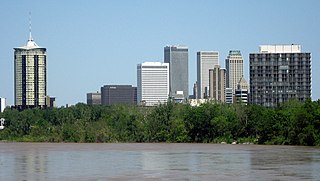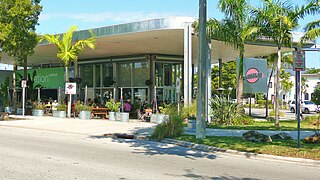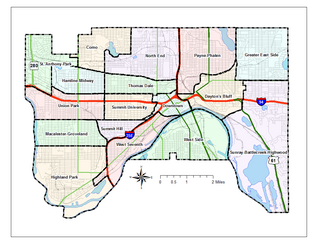
Winter Park is a city in Orange County, Florida, United States. The population was 29,795 according to the 2020 census. It is part of the Orlando–Kissimmee–Sanford, Florida Metropolitan Statistical Area.

Cleveland Park is a residential neighborhood in the Northwest quadrant of Washington, D.C. It is located at 38°56′11″N77°3′58″W and bounded approximately by Rock Creek Park to the east, Wisconsin and Idaho Avenues to the west, Klingle and Woodley Roads to the south, and Rodman and Tilden Streets to the north. Its main commercial corridor lies along Connecticut Avenue NW, where the eponymous Cleveland Park station of the Washington Metro's Red Line can be found; another commercial corridor lies along Wisconsin Avenue. The neighborhood is known for its many late 19th century homes and the historic Art Deco Uptown Theater. It is also home to the William L. Slayton House and the Park and Shop, built in 1930 and one of the earliest strip malls.
The Millionaires' Mile, Millionaires' Row, Billionaires' Row, Golden Mile or Alpha Street are the exclusive residential neighborhoods of various cities, often along one scenic strip such as a riverside or hilltop drive, or a wide city boulevard.
Trinidad is a neighborhood located in Ward 5, in the northeast quadrant of Washington, D.C., and is a largely residential area. Bounded by West Virginia Avenue NE, Florida Avenue NE, Mount Olivet Road NE, and Bladensburg Road NE

Collinwood is a historical area in the northeast part of Cleveland, Ohio. Originally a village in Euclid Township, it was annexed by the city in 1910. Collinwood grew around the rail yards of the Lake Shore and Michigan Southern Railway and is divided by these same tracks into the neighborhoods of North Shore Collinwood and Collinwood–Nottingham. Collinwood was identified as one of America's Best Secret Neighborhoods by Travel + Leisure in 2008.

Tulsa is the second-largest city in the state of Oklahoma. It has many diverse neighborhoods due to its size.

The East Side is a district of Milwaukee, Wisconsin consisting of several neighborhoods encompassing an area just north of Downtown Milwaukee to the village of Shorewood, bordered by the Milwaukee River to the west and Lake Michigan to the east. The area encompasses residences, museums, bars, shops, theaters, live music clubs and the University of Wisconsin–Milwaukee campus.

The Kenwood Historic District is a district located in St. Petersburg, Florida U.S.A. It was designated on August 4, 2003, and is located immediately west of downtown, bounded by 9th Avenue North, 1st Avenue North, 19th Street North and 34th Street North. It contains 2,203 historic buildings. The Grand Central adjoins the district at its southern boundary.

The neighborhoods of Milwaukee include a number of areas in southeastern Wisconsin within the state's largest city at nearly 600,000 residents.
Greenland Hills is a neighborhood in east Dallas, Texas, United States. It is bounded on the west by North Central Expressway, on the south by Vanderbilt Avenue, on the east by Greenville Avenue and on the north by McCommas Boulevard.

Cermak Road, also known as 22nd Street, is a 19-mile, major east–west street on Chicago's near south and west sides and the city's western suburbs. In Chicago's street numbering system, Cermak is 2200 south, or twenty-two blocks south of the baseline of Madison Street. Normally, one mile comprises eight Chicago blocks, but the arterial streets Roosevelt Road, formerly named Twelfth Street and at 1200 South, and Cermak Road were platted before the eight-blocks-per-mile plan was implemented. Roosevelt Road is one mile south of Madison Avenue and there are twelve blocks within that mile. Cermak Road is two miles south of Madison Avenue and there are ten blocks within the mile between Roosevelt and Cermak Roads.

The Upper Eastside is a neighborhood in Miami, Florida. It is north of Edgewater, east of Little Haiti, south of the village of Miami Shores, and sits on Biscayne Bay. In geographical order from south to north and east to west, it contains the subdivisions of Magnolia Park, Bay Point, Morningside, Bayside, Belle Meade, Shorecrest, and Palm Grove. The MiMo District along Biscayne Boulevard in the area is host to many art galleries, shops and restaurants.

Southampton is a neighborhood in St. Louis, Missouri. Located in the southwestern reaches of the city, its borders are Chippewa Street on the north, Hampton Avenue on the west, Eichelberger Street on the south, and South Kingshighway Boulevard on the east.

Saint Paul, Minnesota, consists of 17 officially defined city districts or neighborhoods.
College Park is a distinct neighborhood within the city of Orlando, Florida, deriving its name from the many streets within its bounds that were named for institutions of higher learning such as Princeton, Harvard, and Yale. Its close proximity to downtown has made it a popular residential area for over a century among seniors and young professionals. According to the 2000 census, most residents are of working age and are homeowners. Of them, 65.5% of households have no children.
Pine Hills is a neighborhood in Albany, New York, generally defined as the area from Manning Boulevard to the west, Woodlawn Avenue to the south, Lake Avenue to the east, and Washington Avenue to the north. The neighborhood consists mainly of freestanding multi-unit, duplex, and semi-detached houses and is home to Albany High School, the LaSalle school, and the Alumni Quad of the University at Albany. It was the home of The College of St. Rose. Though mostly residential due to historical reasons from its founding, Pine Hills is home to two neighborhood commercial districts ; Middle Madison, from Partridge to Quail streets was designated first, and then a latter designated district, Upper Madison, from Main Avenue to North Allen Street. The area of Pine Hills east of Main Avenue and north of Myrtle Avenue is commonly referred to as the student ghetto due to its predominant population of college-age students. The area of Pine Hills west of Main Avenue features many large Queen Anne, Folk Victorian, and Colonial Revival homes. Upper Madison, where it meets Western Avenue near St. Rose is the center of a commercial area, complete with a movie theater, grocery store, fast food strip mall, retail, restaurants, a library, community playhouse, police station, pharmacy, and elementary school.

Vailsburg is a neighborhood in the city of Newark in Essex County, in the U.S. state of New Jersey. Part of the West Ward, its elevation is 280 feet (85 m). As of 2000, Vailsburg had a population of 34,348. The Vailsburg section of Newark is on a hill which closely aligns with the suburban and park areas outside it. Vailsburg includes the two smaller neighborhoods of upper Vailsburg and lower Vailsburg, both of which have Sanford Avenue as a focal point. Upper Vailsburg is closer to Maplewood and South Orange.
There are several neighborhoods in the city of Pasadena, California











